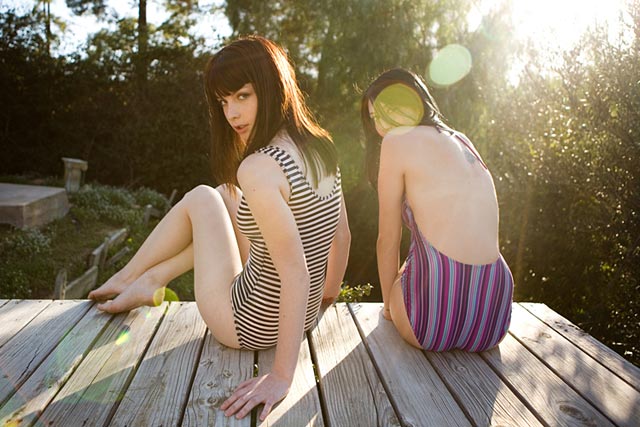Every day, the same, again
Breathable coffee hits the market.
Scientists from the US National Marine Mammal Foundation said that bottlenose dolphins are resistant to insulin - just like people with diabetes. But in dolphins, they say, this resistance is switched on and off.
Swimming with dolphins ‘traumatises’ them, scientists claim.
Welcome to the strange world of globalisation. The bitter battle over bluefin tuna.
It wasn’t us. Alan Greenspan and Ben Bernanke still do not believe monetary policy bears any blame for the crisis.
8 studies demonstrating the power of simplicity.
When doing the right thing could backfire.
Does child sexual abuse cause homosexuality?
Could you tell us a little bit about yourself and your evolutionary approach to fitness?
If you’re a runner and a mother—or if you live with one—maybe you get what I mean.
Crap Space 8. Don’t get me started on how bad a patron of artchitecture New York University is…
Is there a Google news blacklist?
Was Jimi Hendrix’s ambidexterity the key to his virtuosity?
Top 10 celebrity-relationship flameouts.
Blueberries contain more anti-oxidants than other fruit, Eating at night makes you fat , The diet myths that could be ruining your health…
Whole Foods’ new nutritional ratings system ignores 2.4 million yrs of human history.
Make a grocery list and stick to it? It means that you’re both paying more and missing out on the freshest, best-looking food. Buy your groceries European-Style.
7 ways to get jailed or killed while traveling.
6 elements every conspiracy needs. Related: Many millions of people hold conspiracy theories; they believe that powerful people have worked together in order to withhold the truth about some important practice or some terrible event.
Language death should not be confused with language attrition.
This poster hangs in Tokyo sushi restaurants, right next to the choking victim one.
Down into the endless blue wine, I’ll open my head and let out all of my time

Would you be happier if you spent more time discussing the state of the world and the meaning of life — and less time talking about the weather?
It may sound counterintuitive, but people who spend more of their day having deep discussions and less time engaging in small talk seem to be happier, said Matthias Mehl, a psychologist at the University of Arizona who published a study on the subject.
“We found this so interesting, because it could have gone the other way — it could have been, ‘Don’t worry, be happy’ — as long as you surf on the shallow level of life you’re happy, and if you go into the existential depths you’ll be unhappy,” Dr. Mehl said.
photo { Laura Taylor }
‘Always worth more than what I write.’ –Roland Barthes
Finally I went to 104, still musing, alarmed by the grim power of this corner of Paris, passing in front of the hotel Royal-Aboukir (what a name!). All this was like some disinherited New York neighborhood, on the smaller Parisian scale. At dinner (a good risotto, but the beef, of course, not cooked at all), I felt comfortable with friends: A. C., Philippe Roger, Patricia, and a young woman, Frédérique, who was wearing a rather formal gown, its unusual shade of blue soothing; she didn’t say much, but she was there , and I thought that such attentive and marginal presences were necessary to the good economy of a party. (…)
In the taxi on the way home, storm and heavy rain. I hang around the house (eating some toast and feta), then, telling myself I must lose the habit of calculating my pleasures (or my deflections), I leave the house again and go see the new porno film at Le Dragon: as always—and perhaps even more so than usual—dreadful. I dare not cruise my neighbor, though I probably could (idiotic fear of being rejected). Downstairs into the back room; I always regret this sordid episode afterward, each time suffering the same sense of abandonment.
Both in the grey and in reality

{ 1. Grant Willing | 2. David Sherry }
‘Consistency is contrary to nature, contrary to life. The only completely consistent people are dead.’ –Aldous Huxley
We live in a world of complex systems. The environment is a complex system. The government is a complex system. Financial markets are complex systems. The human mind is a complex system—most minds, at least.
By a complex system I mean one in which the elements of the system interact among themselves, such that any modification we make to the system will produce results that we cannot predict in advance.
Furthermore, a complex system demonstrates sensitivity to initial conditions. You can get one result on one day, but the identical interaction the next day may yield a different result. We cannot know with certainty how the system will respond.
Third, when we interact with a complex system, we may provoke downstream consequences that emerge weeks or even years later. We must always be watchful for delayed and untoward consequences.
The science that underlies our understanding of complex systems is now thirty years old. A third of a century should be plenty of time for this knowledge and to filter down to everyday consciousness, but except for slogans — like the butterfly flapping its wings and causing a hurricane halfway around the world — not much has penetrated ordinary human thinking.
On the other hand, complexity theory has raced through the financial world. It has been briskly incorporated into medicine. But organizations that care about the environment do not seem to notice that their ministrations are deleterious in many cases. Lawmakers do not seem to notice when their laws have unexpected consequences, or make things worse. Governors and mayors and managers may manage their complex systems well or badly, but if they manage well, it is usually because they have an instinctive understanding of how to deal with complex systems. Most managers fail.
Why? Our human predisposition treat all systems as linear when they are not. A linear system is a rocket flying to Mars. Or a cannonball fired from a cannon. Its behavior is quite easily described mathematically. A complex system is water gurgling over rocks, or air flowing over a bird’s wing. Here the mathematics are complicated, and in fact no understanding of these systems was possible until the widespread availability of computers.
One complex system that most people have dealt with is a child. If so, you’ve probably experienced that when you give the child an instruction, you can never be certain what response you will get. Especially if the child is a teenager. And similarly, you can’t be certain that an identical interaction on another day won’t lead to spectacularly different results.
If you have a teenager, or if you invest in the stock market, you know very well that a complex system cannot be controlled, it can only be managed. Because responses cannot be predicted, the system can only be observed and responded to. The system may resist attempts to change its state. It may show resiliency. Or fragility. Or both.
An important feature of complex systems is that we don’t know how they work. We don’t understand them except in a general way; we simply interact with them. Whenever we think we understand them, we learn we don’t. Sometimes spectacularly.
Touch the sky. You mean everything to me.

…sooner or later, helium will become more precious than gold. Though best known as the lifting gas in balloons (and the high squeaky voices it evokes when inhaled), helium’s buoyancy, inertness, and other unique properties make it irreplaceable for some of our civilization’s highest technologies. Without large amounts of helium, liquid-fueled rockets cannot be safely tested and launched, semiconductors and optical fibers cannot be easily manufactured, and cryogenically cooled particle accelerators and medical MRI machines cannot function. Helium may also prove crucial as a working fluid or even a fuel in future nuclear reactors. And unlike gold, which can be eternally recovered and shaped to new functions, only very expensive countermeasures can prevent helium, once used, from escaping into the atmosphere and drifting away into outer space.
Helium’s rarity on Earth and relative abundance in America are cosmic and planetary accidents. After hydrogen, helium is the second most common element in the universe, with the bulk of it formed during the big bang.
photo { Stephen Shore }
It’s a secret I want the world to know that you’re mine

Formation of a memory is widely believed to leave a ‘trace’ in the brain - a fleeting pattern of electrical activity which strengthens the connections within a widely distributed network of neurons, and which re-emerges when the memory is recalled. The concept of the memory trace was first proposed nearly a century ago, but the nature of the trace, its precise location in the brain and the underlying neural mechanisms all remain elusive. Researchers from University College London now report that functional magnetic resonance (fMRI) can be used to decode individual memory traces and to predict which of three recently encoded memories is being recalled.
photo { Sebastian Kim }
Mr. Sansweet didn’t asked to be saved. Mr. Sansweet didn’t want to be saved. And the injuries received from Mr.Incredible’s ‘actions,’ so-called, causes him daily pain.
I’m writing to you to settle a dispute between my husband and me. We have been married for six years. We’re not terribly adventurous, but we’re not totally vanilla, either. However, there is one issue that is driving me insane: My husband constantly pesters me to have anal sex. We have tried it in the past, and it is NOT my bag. I don’t enjoy it AT ALL. But my husband will not stop pestering me. He thinks if we just keep trying, eventually I’ll come around to liking it. I’m pretty GGG [good giving and game] , Dan, but this is one thing where I draw the line. He thinks I’m being unreasonable; I think he is. Do I need to give in, or does he need to get off my back? Needing Expert Advice!
‘Everyone who wants to do good to the human race always ends in universal bullying.’ –Aldous Huxley

{ Wound Man is an illustration which first appeared in European surgical texts in the Middle Ages. It laid out schematically the various wounds a person might suffer in battle or in accidents, often with surrounding or accompanying text stating treatments for the various different injuries. | Wikipedia | Continue reading }
‘The only clever word is yes.’ –Gilles Deleuze
Is mental illness good for you?
Mental illness is surprisingly common. About 10% of the population is affected by it at any one time and up to 25% suffer some kind of mental illness over their lifetime. This has led some people (many people in fact) to surmise that it must exist for a reason – in particular that it must be associated with some kind of evolutionary advantage. Indeed, this is a popular and persistent idea both in scientific circles and in the general public.
Such theories come in two main varieties – the first, that mental illness confers some specific advantage to those afflicted; and second, that the mutations which cause mental illness in one person’s genetic background may confer an advantage when they are in a different genetic background (balancing selection).
‘Time is the best author. It always writes the perfect ending.’ –Charlie Chaplin, Limelight, 1952

When people think of knowledge, they generally think of two sorts of facts: facts that don’t change, like the height of Mount Everest or the capital of the United States, and facts that fluctuate constantly, like the temperature or the stock market close.
But in between there is a third kind: facts that change slowly. These are facts which we tend to view as fixed, but which shift over the course of a lifetime. For example: What is Earth’s population? I remember learning 6 billion, and some of you might even have learned 5 billion. Well, it turns out it’s about 6.8 billion. (…)
These slow-changing facts are what I term “mesofacts.” Mesofacts are the facts that change neither too quickly nor too slowly, that lie in this difficult-to-comprehend middle, or meso-, scale. (…)
Updating your mesofacts can change how you think about the world. Do you know the percentage of people in the world who use mobile phones? In 1997, the answer was 4 percent. By 2007, it was nearly 50 percent.
photo { Daemian and Christine }
‘My loathings are simple: stupidity, oppression, crime, cruelty, soft music.’ –Nabokov

About 3,000 New York City taxi drivers routinely overcharged riders over two years by surreptitiously fixing their meters to charge rates that would normally apply only to trips outside the five boroughs, according to the city’s Taxi and Limousine Commission.
The drivers’ scheme, the commission said, involved 1.8 million rides and cost passengers an average of $4 to $5 extra per trip. The drivers, officials said, flipped switches on their meters that kicked in the higher rates, costing New York City riders a total of $8.3 million.
The 1.8 million fares represent a tiny fraction of a total 360 million trips over the 26-month period in question.
photo { Terry Richardson | Related: After two models spoke out about Terry Richardson’s alleged sexual misconduct on shoots, Jezebel asked readers to write in with any stories they may have about the prolific photographer. | NY mag | full story }
Philosophers give ideas away for free, if you think about it

MOMA’s founding director and “intellectual creator” viewed Johns’ first solo show at Leo Castelli and telephoned MOMA curator Dorothy Miller to come right over so they could select works. They purchased Johns’ 1954 Flag, Green Target, Target with Four Faces and White Numbers (thus anointing the 28-year-old into the modernist pantheon).
{ Art Net | Continue reading }
Rauschenberg opened up the possibilities that are now being mined by contemporary con-artists such as Damien Hirst, Mike Kelley, and Jeff Koons. Rauschenberg didn’t poeticize the ordinary. He aggrandized the ordinary, he put a high-art style price tag on the ordinary.
{ The New Republic | Continue reading }
$12 million, that’s how much Damien Hirst’s famous shark sold for in 2005. …. It’s not just about the work of art; rather, the value placed on a particular work derives from how it feels to own that art. Most art dealers know that art buying is all about what tier of buyers you aspire to join, about establishing a self-identity and, yes, getting some publicity. The network of galleries and auction houses spends a lot of its time, money, and energy giving artworks just the right image. Remarkably, buyers support the process in the interest of coming out on top, rather than fighting it and trying to get the lower prices. ….
art critics don’t matter much anymore. If the magazine Art in America pays $200 for a review article, why listen to that writer? We have a much richer and generally more accessible guide to the value of art — namely the market itself. ….
Damien Hirst is now worth more than Dali, Picasso, and Warhol were at the same age, put together. The point isn’t whether, in aesthetic terms, he deserves that compensation. The question is whether this way of organizing the art market makes overall sense.
Earlier this year, hedge-fund millionaire Daniel Loeb made a sweet trade. The 43-year-old partner at Third Point LLC had purchased a rare asset in 2003. He found a buyer in January and sold it for a 500% profit, making a quick $1 million. …
Hedge-fund managers are reinventing the art of the art deal. With their sudden riches, quest for status and big houses in need of adornment, fund managers have become some of the most active buyers and sellers in the art world.
They have been buying up hundreds of millions of dollars of paintings, sculptures and pop-art installations. They have helped turn middling artists into media stars. … where others see art, many fund managers see another market ripe for trading, buying, selling and flipping. Many invest heavily in one or two artists, to build up a “position.” They promote the value of the artists, help boost their prices and sometimes later unload pieces through a tax-favorable gift or sale.
“Who makes that kind of money in the stock market?” said Sender, 38, as he swiveled round the 21 screens at his desk in New York. “In the hedge-fund business these days, you’re having a great year if you make 20 percent.”
Sender revamped his hedge fund Exis Capital Management Inc. last year, returning some investors’ money after losses in 2004 and 2006. Meanwhile, the value of his art, with works by Richard Prince, Mike Kelley and Andreas Gursky, has continued to rise, quadrupling in 10 years.
Art is now his biggest single asset — 800 works that Sender values at more than $100 million. He said he recouped most of the $25 million he spent in the past 10 years on art with the sale of about 40 pieces.
Sender is a new type of financier collector, with Steven Cohen and Daniel Loeb. Their gains on works by Prince and Martin Kippenberger aren’t just dumb luck in a boom. They apply rules for buying art, as well as stocks.
Sender tries to buy the best works of artists he admires, whose pieces also are being acquired by museums and other collectors.
{ Bloomberg | Continue reading }
When a big-name artist has a gallery show at a big-name gallery like White Cube or Gagosian, his best paintings aren’t even on public view: “The new buyer has little chance of even seeing the hot paintings, which will be kept in a small private room. What is hung in public areas is available for purchase but of lesser significance.” ….
One of the things which fascinates me about the recent run-up in contemporary art prices is that it’s meant a huge change in the way that many artists work: it’s commonplace nowadays for artists to have dozens of assistants, something which was a decidedly unusual and controversial practice back in the days of Warhol. With prices for new works regularly breaking into seven figures, art has become bigger and more polished; it often uses much more expensive materials and can draw on resources which would have been unthinkable 15 years ago.
{ Portfolio | Continue reading }
To Mr. Galenson markets are what make the 20th century completely different from other eras for art. In earlier periods artists created works for rich patrons generally in the court or the church, which functioned as a monopoly. Only in the 20th century did art enter the marketplace and become a commodity, like a stick of butter or an Hermès bag. In this system, he said, breaking the rules became the most valued attribute. The greatest rewards went to conceptual innovators who frequently changed styles and invented genres. For the first time the idea behind the work of art became more important than the physical object itself.
artwork { Ellsworth Kelly }
‘Everything that irritates us about others can lead us to an understanding of ourselves.’ –Carl Jung
There is increasing awareness within the Defense Department that wars are interactively complex or “wicked” problems. (…) This article will examine the challenges interactively complex problems pose to U.S. military planning and doctrine. It will offer some modest suggestions for dealing with these problems. We use the terms “interactively complex,” “ill-structured” and “wicked” interchangeably throughout the article. (…)
Ill-structured problems are interactively complex. By definition, these problems are nonlinear. Small changes in input can create massive changes in outcome, and the same action performed at different times may create entirely different results. It is very difficult if not impossible to predict what will happen. Yet our war-planning process often promulgates detailed plans for well over the first 100 days of a conflict. Obviously, the true value of planning comes from the interactions of those doing the planning, not the plan itself. By shifting our planning focus from details of the plan to defining the problem, we can reap the benefits of intensive planning while exploring other problem definitions that should drive branch planning.
Ill-structured problems have no “stopping rule.” By definition, wicked problems have no end state. Rather, the planner must seek a “good enough” solution based on maintaining equilibrium around some acceptable condition. Unfortunately, our doctrine and practice continue to focus on developing an end state for every plan. When dealing with wicked problems, thinking in terms of an end state will almost certainly lead to failure. Instead, we should think about how to sustain “steady state” over the long term. While apparently a semantic quibble, accepting that wicked problems don’t “end” is vitally important for campaign planners and commanders alike.
‘To believe that what is true for you in your private heart is true for all men–that is genius.’ –R. W. Emerson

An American essayist, poet, and popular philosopher, Ralph Waldo Emerson (1803–82) began his career as a Unitarian minister in Boston, but achieved worldwide fame as a lecturer and the author of such essays as “Self-Reliance,” “History,” “The Over-Soul,” and “Fate.”
He influenced generations of Americans, from his friend Henry David Thoreau to John Dewey, and in Europe, Friedrich Nietzsche, who takes up such Emersonian themes as power, fate, the uses of poetry and history, and the critique of Christianity. (…)
Emerson is in many ways a process philosopher, for whom the universe is fundamentally in flux and “permanence is but a word of degrees.” Even as he talks of “Being,” Emerson represents it not as a stable “wall” but as a series of “interminable oceans.” This metaphysical position has epistemological correlates: that there is no final explanation of any fact, and that each law will be incorporated in “some more general law presently to disclose itself.” (…)
Nietzsche read German translations of Emerson’s essays, copied passages from “History” and “Self-Reliance” in his journals, and wrote of the Essays: that he had never “felt so much at home in a book.” Emerson’s ideas about “strong, overflowing” heroes, friendship as a battle, education, and relinquishing control in order to gain it, can be traced in Nietzsche’s writings.
It’s incredibly obvious, isn’t it? A foreign substance is introduced into our precious bodily fluids without the knowledge of the individual.

Stanley Kubrick’s Dr. Strangelove or: How I Learned to Stop Worrying and Love the Bomb (1964)’s frightening absurdity was established in the very first frame of the main title sequence designed by Pablo Ferro. (…)
Surprinted on these frames the film’s title and credits are full-screen graffiti-like scrawls comprised of thick and thin hand-drawn letters, unlike any movie title that had preceded it. (…)
It launched the long career of Pablo Ferro as title designer, trailer director, and feature filmmaker. Yet before he started designing film titles the Cuban born Ferro (b 1935), who had emigrated to New York City when he was twelve years old - and quickly became a huge film fan and aficionado of UPA cartoons - had earned a reputation for directing and editing scores of television commercials. After graduating from Manhattan’s High School of Industrial Art, Ferro began working at Atlas Comics in 1951 as an inker and artist in the EC-horror tradition. (…)
As a consummate experimenter, Ferro introduced the kinetic quick-cut method of editing whereby static images (including engravings, photographs, and pen and ink drawings) were infused with speed, motion, and sound. In the late 1950s most live-action commercials were shot with one or two stationary cameras, conversely Ferro took full advantage of stop-motion technology, as well shooting his own jerky footage with a handheld Bolex. Unlike most TV commercial directors, Ferro maintained a strong appreciation and understanding for typography such that in the late 1950s he pioneered the use of moving type on the TV screen. (…)
Ferro’s title for The Thomas Crown Affair, directed by Norman Jewison in 1968, introduced multi-screen effects for the first time in any feature motion picture and defined a cinematic style of the late 1960s. (…)
The Thomas Crown Affair won an Academy Award and served as a model for other films of that era (remember Woodstock?). It also convinced Steve McQueen, who starred in and produced the film, to hire Ferro to do titles for his next movie, Bullitt, which launched an uninterrupted thirty-year string of title and trailer commissions. (…)
One of his most engaging recent title sequences, edited with his son Allen Ferro, for the 1995 murder farce To Die For, directed by Gus Van Sant, gave him an opportunity to test how far he could develop the film’s leading character in the few minutes prior to the start of the action.
screenshots { Dr. Strangelove }
bonus:













